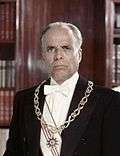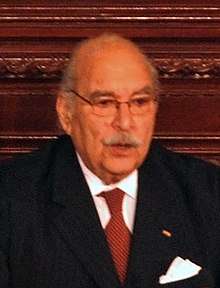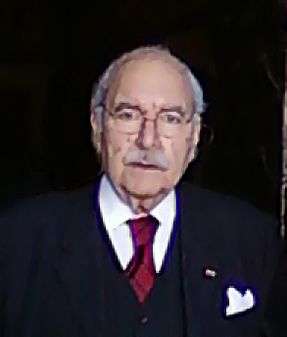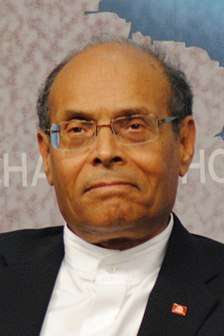List of Presidents of Tunisia
 |
|---|
| This article is part of a series on the politics and government of Tunisia |
|
Judiciary |
| Foreign relations |
This page lists the holders of the office of President of Tunisia and those who have acted in that capacity in the absence of a sworn President.
Background
Tunisia has had five Presidents since the proclamation of the republic on July 25, 1957:
- President Habib Bourguiba was appointed President by the parliament on July 25, 1957, until the election of a permanent president. After the Constitution was enacted on June 1, 1959, a presidential election was held on November 8, 1959. Being the only one running for office, he gained 91% of the votes to serve a 5-year term. Bourguiba will serve 3 more terms, proclaiming himself President for Life during the fourth before being overthrown in the coup d'état of November 7, 1987, organized by his Prime Minister Ben Ali.
- President Zine El Abidine Ben Ali was Prime Minister and Minister of Interior under President Bourguiba. Ben Ali impeached Bourguiba for medical purposes on November 7, 1987, thus assuming the office of second and acting President of Tunisia, until the election of a permanent president. Ben Ali was elected on April 2, 1989, to serve a 5-year term followed by 3 other terms. On January 14, 2011, his regime fell in the Tunisian Revolution that started on December 17, 2010. Mohamed Ghannouchi, his Prime Minister, claimed the presidency, serving as acting President.
- President Fouad Mebazaa was, at first, designated by the Constitutional Council to serve as an acting President, on January 15, 2011. Under Article 57 of the Constitution, an election should have taken place between 45 and 60 days following Mebazaa's appointment. But on March 3, 2011, he announced the repeal of the 1959 Constitution and the election of a constituent assembly which had to draft a new one. Therefore, he became Interim President and the 3rd one of Tunisian history until the election of a new President.
- President Moncef Marzouki was elected 3rd President of Tunisia by the Tunisian Constituent Assembly, on December 12, 2011. The next day, he was inaugurated, making him the first president not to be member of the ruling party. During the 2014 presidential election, he was defeated by former Prime Minister Caid Essebsi and left office on December 31, 2014.
- President Beji Caid Essebsi became the 4th and the first democratically elected president by universal suffrage after the Revolution, on December 21, 2014. He is the current President of Tunisia since December 31, 2014.
List
- Status
Denotes Acting President
|
Neo Destour/SDP/DCR (2) Congress for the Republic (1) Nidaa Tounes (1) | ||||||||||
|---|---|---|---|---|---|---|---|---|---|---|
| No. | Portrait | President | Time in office | Party | Term | |||||
| 1 |  |
Habib Bourguiba August 3, 1903 – April 6, 2000 (aged 96) |
July 25, 1957 – November 7, 1987 |
Neo-Destour | I [1] |
July 25, 1957 – November 8, 1959 | ||||
| 1 (1959) |
November 8, 1959 – November 8, 1964 | |||||||||
| SDP | 2 (1964) |
November 8, 1964 – November 2, 1969 | ||||||||
| 3 (1969) |
November 2, 1969 – November 3, 1974 | |||||||||
| 4 (1974) [2] |
November 3, 1974 – November 7, 1987 | |||||||||
| 2 |  |
Zine El Abidine Ben Ali Born: September 3, 1936 |
November 7, 1987 – January 14, 2011 |
SDP | A [3] |
November 7, 1987 – April 2, 1989 | ||||
| DCR | 1 (1989) |
April 2, 1989 – March 20, 1994 | ||||||||
| 2 (1994) |
March 20, 1994 – October 24, 1999 | |||||||||
| 3 (1999) |
October 24, 1999 – October 24, 2004 | |||||||||
| 4 (2004) |
October 24, 2004 – October 25, 2009 | |||||||||
| 5 (2009)[4] |
October 25, 2009 – January 14, 2011 | |||||||||
| Mohamed Ghannouchi, acting President from January 14 to January 15, 2011.[5] | ||||||||||
| 3 |  |
Fouad Mebazaa Born: June 15, 1933 |
January 15, 2011 – December 13, 2011 |
DCR [6] |
A [7] |
January 15, 2011 – March 3, 2011 | ||||
| Non-partisan | I [8] |
March 3, 2011 – December 13, 2011 | ||||||||
| 4 |  |
Moncef Marzouki Born: July 7, 1945 |
December 13, 2011 – December 31, 2014 |
Congress for the Republic | I [9] |
December 13, 2011 – December 31, 2014 | ||||
| 5 |  |
Beji Caid Essebsi Born: November 29, 1926 |
December 31, 2014 – Incumbent |
Nidaa Tounes | 1 (2014) |
December 31, 2014 – Incumbent (Term expires on December 31, 2019) | ||||
Rank by time in office
| Rank | President | Time in office |
|---|---|---|
| 1 | Habib Bourguiba | 30 years, 105 days |
| 2 | Zine El Abidine Ben Ali | 23 years, 68 days |
| 3 | Fouad Mebazaa | 332 days |
| 4 | Moncef Marzouki | 3 years, 18 days |
| 5 | Beji Caid Essebsi (Incumbent) | 3 years, 285 days |
Living former Presidents
There are three living former Tunisian Presidents:

Zine El Abidine Ben Ali
(1987–2011)
September 3, 1936
Fouad Mebazaa
(2011)
June 15, 1933
Moncef Marzouki
(2011–14)
July 7, 1945
Timeline

Footnotes
- ↑ On July 25, the National Constituent assembly proclaimed the republic. Prime Minister Bourguiba thus was designated by the parliament as President of the Republic until the election of a new president, after drafting the constitution.
- ↑ During this term, Bourguiba proclaimed himself President for Life and served in that capacity until he was deposed in the 1987 coup d'état.
- ↑ Following the 1987 coup d'état, Prime Minister Ben Ali took office as Acting President of Tunisia until the election of a permanent president.
- ↑ During this term, Ben Ali was deposed in the Tunisian Revolution.
- ↑ Mohamed Ghannouchi claimed the Presidency on January 14, 2011. Therefore, he was acting president until the Constitutional Council spoke out and declared Ben Ali deposed. Under Article 57, Ghannouchi was replaced by Fouad Mebazaa.
- ↑ Mebazaa left the party leadership on January 18 while the DCR was dissolved on March 9, 2011.
- ↑ Acting President
- ↑ Fouad Mebazaa was first appointed acting President on January 15, 2011. Under Article 57 of the Constitution, an election should have taken place between 45 and 60 days following Mebazaa's appointment. But on March 3, 2011, he announced the repeal of the 1959 Constitution and the election of a constituent assembly which had to draft a new one. Therefore, he became interim President and the 3rd one of Tunisian history until the election of a permanent President. Thus, instead of taking office for 45 to 60 days, he was President for nearly a year.
- ↑ Marzouki was elected by the National Constituent Assembly as interim President of Tunisia until the drafting of a new constitution and the election of a permanent president.
See also
External links
This article is issued from
Wikipedia.
The text is licensed under Creative Commons - Attribution - Sharealike.
Additional terms may apply for the media files.